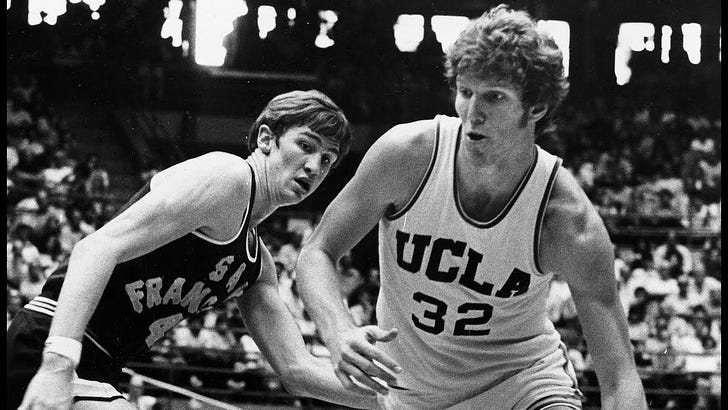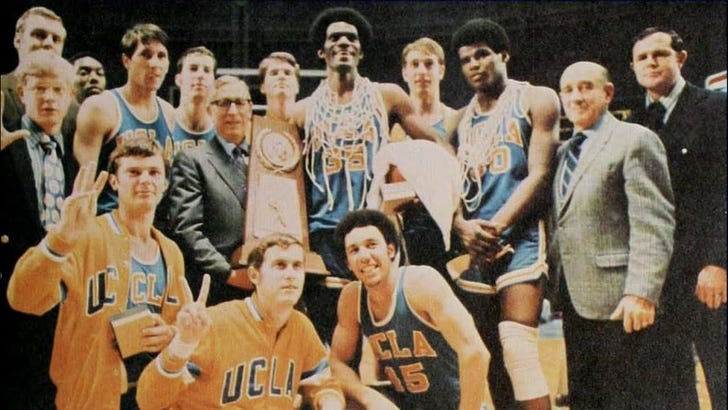Pac-12 Tuesday: The End of Sports Greatest Dynasty
Any number of teams across a variety of sports can make a compelling case as the greatest dynasty of all-time: The Montreal Canadiens of 1976-1979 and the New York Islanders that immediately followed from 1980 through 1983; Michael Jordan’s Chicago Bulls in the 1990s; the New York Yankees of both the Great Depression era and post-World War II years.
For me, however, UCLA basketball from 1964 through 1975 sets the standard. The Bruins won 10 national championships with regularly rotating rosters, which inherently ups the degree of difficulty compared to professional sports. The Bulls had the constant of Jordan at his peak, the Canadiens boasted Guy LaFleur and Ken Dryden, the Yankees featured Joe DiMaggio, Mickey Mantle, Phil Rizzuto.
UCLA had the constant of John Wooden, of course, but great coaching is only one ingredient in a championship-winning formula. It takes players, and colleges routinely have to replace them — hence why, since 1975, there have been only two repeat Final Four winners.
Yes, UCLA benefited in its dominant run from building around arguably the two greatest college basketball players of all-time for different periods: Kareem Abdul-Jabbar and Bill Walton.
However, that fails to give fair consideration to Bruins teams that won national titles with Freddie Goss, Kenny Washington, Walt Hazzard, Sidney Wicks — all outstanding college basketball players, but none among the greatest ever in the game.
What’s more, UCLA ruled a sport that, even before basketball featured the talent and parity it has now, thrived on chaos. A single-elimination tournament inherently welcomes upheaval, evident in instances like 1971.
The Bruins won their eighth straight national championship that year at the conclusion of a tournament in which they beat a Jerry Tarkanian-coached Long Beach State team in the West Regional Final, 57-55; held off Kansas in the semis, 68-60; and edged Villanova in the title round, 68-62.
Now, the following season was another story with Bill Walton joining the varsity roster. He immediately establishing himself as one of the best to ever play in college. Walton averaged 21.1 points and 15.5 rebounds per game as the 1971-72 Bruins stormed to a 30-0 final record and walloped every NCAA Tournament until Florida State gave UCLA a handful in the National Championship Game.
UCLA ran the table again the following season and faced no resistance in the postseason this time. This past spring 2023 marked the 50-year anniversary of Walton playing the best individual game in National Championship Game history — and arguably, the greatest single performance ever in college basketball.
Some backstory on what inspired this particular newsletter entry: I was chatting with some friends this week and the subject of Bill Walton’s abbreviated NBA career came up. Someone mentioned how fascinating it is that there are entire generations of basketball fans who know Charles Barkley and Bill Walton as goofball TV personalities and not as two of the best players ever.
It was a great point, though a key difference for Barkley: He came into the NBA with Michael Jordan, after Larry Bird and Magic Johnson had begun to grow the league’s popularity exponentially. Barkley’s exploits appeared on national broadcasts, his highlights on SportsCenter when that mattered, and he starred in memorable commercials that encapsulated his stardom.
Injuries cut Walton’s pro career short just before the’80s boom at a time when the big man was on his way to potentially becoming the best player in the world. He won Most Valuable Player in his fourth season, which was also his last before the fateful foot injury altered his direction forever.
Based on his UCLA career and coupled with how quickly he became both an MVP and champion in the NBA, it’s really not a stretch to suggest a healthy Walton would have been the pinnacle of the pros around say, 1981. And that makes the 50-year anniversary this coming college basketball brings all the more noteworthy.
The 1973-74 season was the first in a decade that ended with a team other than UCLA claiming the national championship — it was a North Carolina State team featuring another legendary college star with a what-if NBA career, David Thompson.
The book The Road to Madness: How the 1973-1974 Season Transformed College Basketball is both the last I read before COVID-19 shut down the world in 2020, and more importantly, a terrific retrospective on a pivotal edition of the NCAA Tournament.
Among the changes ushered in after the ‘74 Tournament was the introduction of at-large conference bids. Adding more teams — and more quality teams from strong leagues, to boot — contributing to making the NCAA Tournament more potentially chaotic.
The move came too late for UCLA rival USC, which had arguably its best team in program history the same year the Wooden Bruins were at perhaps their most vulnerable.
The 1970-71 Trojans went 24-2 with several quality wins and the lone defeats coming in fiercely contested Pac-8 games. Both losses just happene to be against UCLA, earning the Bruins the conference championship and thus the Tournament bid.
Perhaps the Trojans could have finally broken through in the postseason; a common basketball cliche is that it’s exceedingly difficult to beat the same opponent three times in the same season.
But, USC didn’t get the opportunity because UCLA so thoroughly dominated the Pac-8 throughout its dynasty.
For that reason, I consider the 1973-74 season the official end of sport’s single-greatest dynasty.
UCLA regrouped a year after losing in the ‘74 Tournament to win a 10th and final national championship under John Wooden. The Bruins beat some damn good teams in March, too, including second-ranked Kentucky in the title game; Louisville in an overtime classic in the national semifinal; and an Arizona State program just a few years shy of moving to the Pac-8 in the Regional Final.
UCLA’s March ‘75 run began, fittingly, with a Pac-8-clinching win over USC that ostensibly denied the Trojans an at-large opportunity the first year the NCAA awarded them.
However, in 1975, UCLA’s air of invincibility in the Pac-8 had ended and that signals the end of the Bruins dynasty.
UCLA finished the 1974-75 Pac-8 season 12-2 in the conference, including a blowout loss at Washington. The 103-81 defeat to a Huskies team that came into the Feb. 22 contest .500 in the Pac-8, 5-5, is a fact as startling as the 22-point margin being the widest in a UCLA loss in a decade.
The Bruins previously dropped a 64-60 decision at Stanford. The Washington rout ensured UCLA would finish with multiple conference losses for the second time in as many seasons.
Ahead of the 1974 Tournament, a Bruins lineup that included a senior Bill Walton, for two years the best player in college basketball, dropped consecutive Pac-8 games on a weekend trip to Oregon and Oregon State.
Now, the above referenced book Road to Madness goes into some detail about UCLA’s lost weekend in the Pacific Northwest. Walton was becoming increasingly political active on campus and outspoken in the press, and how it perhaps impacted the infallible aura John Wooden have long given off.
How much of UCLA falling short in ‘74 was a result of the meticulously straight-laced Wooden clashing with an increasingly free-spirited Walton makes of fascinating debate. It’s also inconsequential for this exercise: Whatever the contributing factors, UCLA basketball was no longer the preeminent dynasty of its time, and no one has matched it since.
There are franchises or programs that could make compelling arguments for having filled the void in the last half-century: UConn women’s basketball, perhaps; North Dakota State football.
However, for as dominant as it’s been under Geno Auriemma, UConn never won nine straight championships. North Dakota State came close in the 2010s, but the Bison didn’t have rules changed quite literally in response to their dominance as the NCAA did when it banned dunking to limit Kareem.
It didn’t work, of course.
There’s never been a match for UCLA basketball in 50 years, and there probably never will be.




